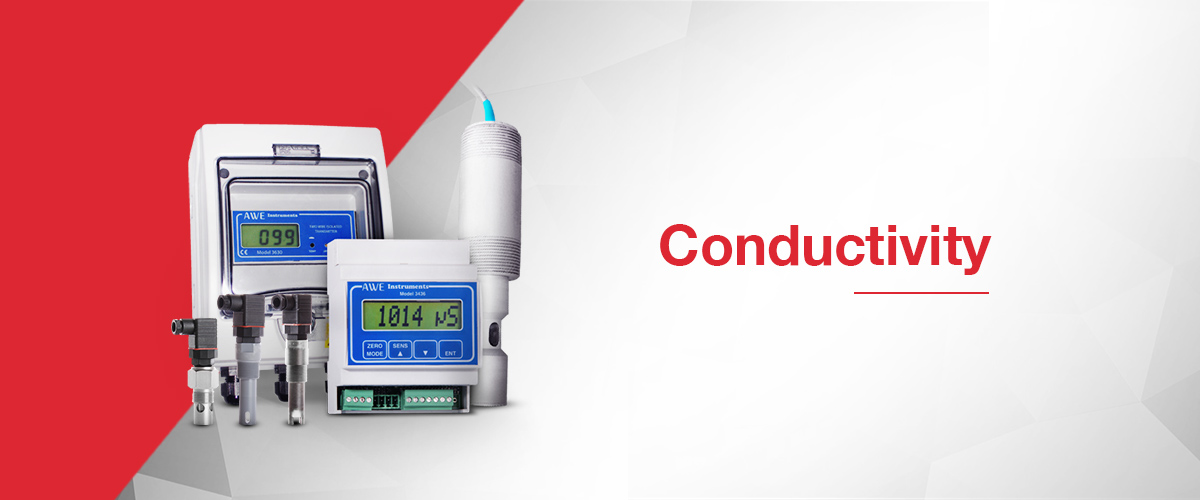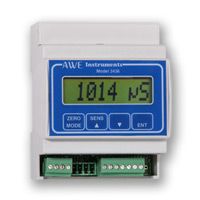Conductivity (EC)
Conductivity or Electrical Conductivity (EC) is the measurement of the electrical conductance of all dissolved ionic species within a measured solution. When we say "all dissolved ionic species dissolved in a solution" this includes all salts, acids, bases and organic substances dissolved within a solution. As the conductivity is the measurement of all these dissolved ions, and using conductivity measurements we cannot differentiate between the ions, we refer to Conductivity as an inferred measurement. (Opposed to pH which is the specific measurement of Hydrogen Ion concentration).
Regardless of being an inferred measurement, Conductivity offers excellent reliability, with quick response times and very precise readings.
Conductivity is expressed as the reciprocal of electrical resistance - Conductivity = 1 / R where R is electrical resistance measured in Ohms (Ω). Initially conductivity was expressed in Mhos (℧) as suggested by Lord Kelvin in the 19th century, but due to the international system of units (SI) now the measurement of conductivity is expressed in terms of Siemens.
Conductivity is measured using a Conductivity Cell which comprises of two plates of a known size and orienation spaced a known distance apart. The cell constant is calculated my dividing the surface area of the plates by their distance apart. Cell Constant K = L (cm) / A (cm2) .
Conductivity Cell Constants
As the conductivity is measured by the surface area and distance apart of the plates within a conductivity cell - it would be logical to consider the activity at a solution level.
The electrical conductance is affected by the concentration of ions dissolved within a solution, the type of ions, and the disassociation of strong and weak electrolytes.
With a cell with a low cell constant K=0.1 or K=0.01 the plates are very close together to ensure that the ions in a low conductivity solution can be measured, due to the close proximity of the plates. The plates carry an AC current to ensure polarisation without causing an anode / cathode effect coating the plates.
If we were to measure the conductivity of a high conducting solution using our cell with a low cell constant, such as Sea Water, we would find that the ion concentration is too great for our cell. As the ionic concentration is too great all we can measure is that the solution conducts, not the precise conductivity. In this instance we would use a cell where the plates are further apart. This ensures that the ions in our solution have a greater distance to cover and a larger surface area, allowing us to precisely measure the conductivity of the solution. There is more information on conductivity cell constants on the conductivity cell page - and please call us on 01785 254 597 if you need any specific information on this.
Conductivity and Temperature.
Temperature has a significant effect on the measurement of Conductivity. A high temperature increases the amount of energy within the solution; this results in the particles moving through the solution quicker than at a low temperature.
There is also an effect on the disassociation rate of weak electrolytes and potentially on the solution viscosity - both resulting in the solution conductivity being higher than for the same measurement of the same solution at a lower temperature.
As such we strongly recommend temperature compensation for use in process critical applications or where a temperature fluctuation is likely to occur.
Applications of Conductivity measurements
As conductivity is an inferred measurement it means that the number of applications in which it can be used in is wide and varied.
We have conductivity / resistivity meters for measuring ultra pure water (13 Meg Ohm resistance or 0.055µS conductivity) which are commonly used in pharmaceutical / technology sectors.
We also offer conductivity controlled systems for measuring solution strengths. For instance using conductivity we can accurately measure the processing chemicals such as Sulphuric Acid, Hydrochloric Acid, Potassium Chloride or Sodium Hydroxide. Conductivity based solution strength control systems are often used with CIP systems in the brewery and dairy sectors as well as in the metal finishing sector.
Conductivity Instruments & Conductivity Sensors
Portable Conductivity Meter
A Conductivity meter is an instrument which is normally portable so that it can be used in the field.
Our portable Conductivity meters are simple to use and are designed for use in commercial or industrial environments, ideal for coroborating readings from industrial equipment, or for testing samples in the laboratory.
All our conductivity meters use automatic temperature compensation to ensure precision conductivity readings.
Conductivity Transmitter
The Conductivity Transmitter is an instrument that enables the tranmsission of a conductivity signal over a distance of up to 1000m using an industry standard 4-20mA signal.
Specifically designed for simple installation - the same two wires that power the device are the same two wires which transmit the signal, meaning simple inegration with PLC's and data loggers, and digitial chart recorders.
With Zero and Sensitivity controls on the Conductivity Transmitter, periodic calibration is simple, ensuring an accurate conductivity signal is transmitted.
Conductivity Controller
Dip Conductivity Cell
Insertion Conductivity Cell
Our Insertion conductivity cell range are designed to be installed into pipes and vessles to give continuous Conductivity measurements.
With a full range of conductivity cell constants we can offer conductivity measurements from 0 - 200 nS through to 0 - 100mS ranges.
Our insertion conductivity cells include high temperature conductivity cells and high linearity conductivity cells for precision measurements up to 200ºC at over 15 Bar pressure.
Flow Line Conductivity Cell
Our flow line conductivity cells are designed to become a permanent piece of your pipework giving continuous online conductivity measurements.
Our flow line conductivity cells are fitted complete with a quick release fitting ensuring that the conductivity cell can be easily removed for periodic maintenance or calibration.
Available with or without temperature compensation our flow line conductivity cells are excellent way to begin measuring conductivity in a pipe.
Toroidal or Inductive Conductivity Sensor
We offer a range of inductive conductivity sensors which are also known as toroidal conductivity sensors.
These devices operative by applying an ionic current to the measured solution and then measuring the generated electric current to derive the conductivity value.
Most frequently used in CIP applications or for solution strength controls, our toroidal or inductive conductivity sensors are non-fouling which means that they can be used in applications where traditional conductivity sensors are coated by a high volume of suspended solids.
Conductivity Simulator
A conductivity simulator is designed to produce a signal corresponding to a precise conductivity value.
A Conductivity simulator is often used to commission new equipment, electrically calibrate instrumentation (including inductive or toroidal conductivity sensors) as well as fault find or test conductivity instruments
Our conductivity simulator is a portable device and makes an excellent addition to any field engineers standard range of equipment.
Conductivity Calibration Standards
Our Conductivity calibration solutions are known, stable conductivity values which can be used to calibrate conductivity sensors to conductivity instruments, including electrodeless or inductive toroidal conductivity sensors.
Our conductivity calibration solutions can be provided with either a certifcate of conformity, or a certificate of analysis traceable to national standards if requied.
The full suite of Conductivity calibration standards includes the following values:-
- 1000µS
- 2000µS
- 5000µS
- 10000µS











